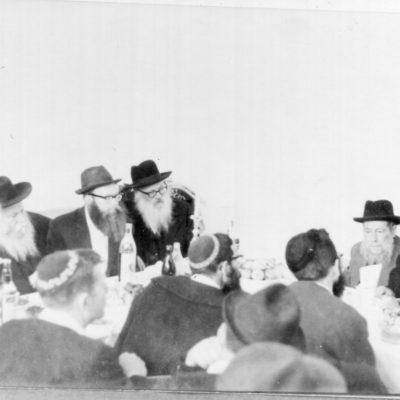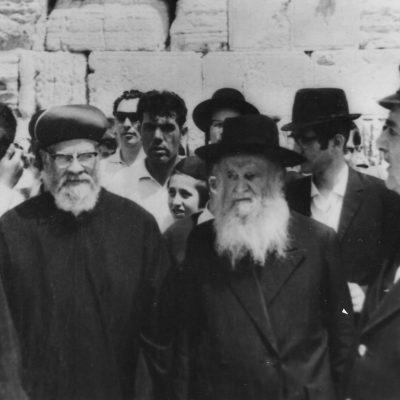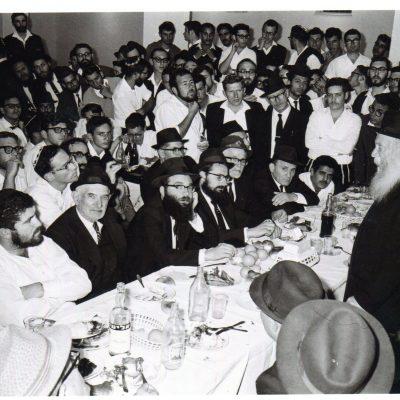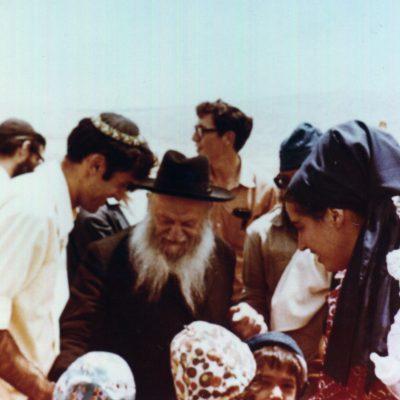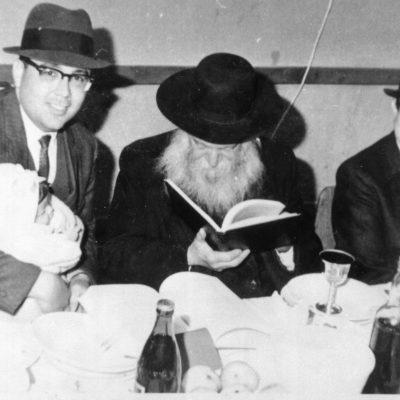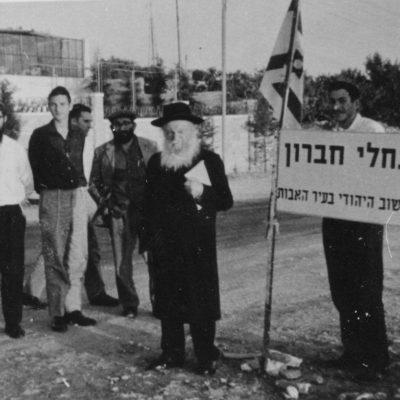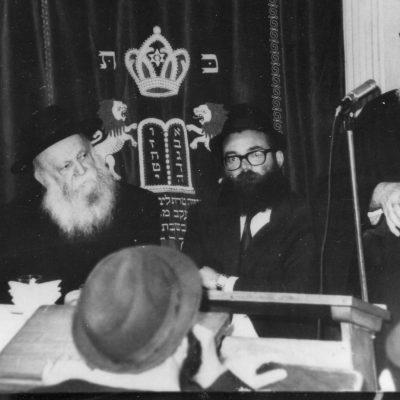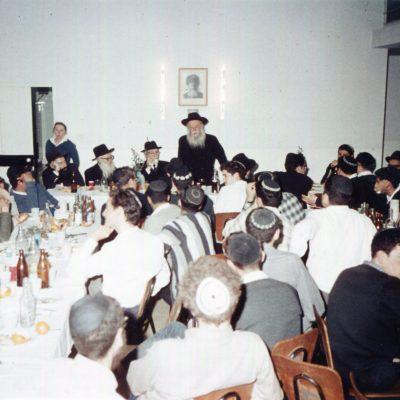Rabbi Tzvi Yehuda, the only son of Rabbi Kook, was one of the most prominent figures in the history of Mercaz HaRav Yeshiva. This prominence was not particularly noticeable at first, since he took a background role when his father was alive. His efforts aimed to pave the way for his father’s philosophy and Torah in the world, to introduce the uniqueness of Rabbi Kook’s teachings among the older yeshiva students who came from abroad, and to the general public and the yeshiva student. After Rabbi Kook’s passing on the third of Elul, 1935, Rabbi Tzvi Yehuda shut himself away for almost twenty years, in order to edit his father’s various writings Emunah and Halacha.
In 1952, the Merkaz HaRav Yeshiva underwent a significant turnaround in the eyes of Israeli public in general and in the religious Zionist community in particular. The Mercaz HaRav Yeshiva once again became one of the most important and prosperous yeshivot in Eretz Yisrael, and Rabbi Tzvi Yehuda was the Rosh Yeshiva of that generation of leaders and rabbanim of Religious Zionist Judaism.
His Life Story
Rabbi Tzvi Yehuda HaKohen Kook was born on Leil Seder Pesach, 1891, the only son alongside two daughters of Rabbi Avraham Yitzchak HaKohen Kook and his wife Rebbetzin Reiza Rivka, the niece of Eliyahu David Rabinowitz-Teomim (the Aderet). He was the eldest of the family, but he was preceded by another sister from his father’s first marriage with the Aderet’s daughter, who died young. He was born in the town of Zeimel in the Kovno district of Lithuania, where his father served as rabbi, and in 1896 the family moved to Levisk, near Riga, where his father was appointed rabbi of the town. After his father was appointed Rabbi of Jaffa, the family made aliyah on 28 Iyar, 1904. This date is remembered as the most significant date in the history of family life, especially after the liberation of Jerusalem occurred on the same date, during the Six Day War.
Jerusalem and Jaffa
His first Gemara teacher was Rabbi Reuven Gottfried (Yedidya), son-in-law of Rabbi Yoel Moshe Salomon. He also studied under Rabbi Moshe Seidel and Rabbi Binyamin Menashe Levin, but the most significant of his studies were with his father. In 1906, he started at Torat Chayim Yeshiva in the Old City, and despite his youth (15 years old), he was placed in the highest shiur in the yeshiva and became very close with the Rosh Yeshiva, Rabbi Zerach Epstein. Rabbi Kook’s letters to his son during this period indicate his satisfaction with his son’s path and the special emotional connection between the two.
After several years of study in Jerusalem, he returned to Jaffa and continued to study Torah with his father. During this period he was one of the initiators of the establishment of the Sha’arei Torah Yeshiva, headed by Rabbi Kook and Rabbi Zalman Shach, and he began to engage in creative writing and publishing his father’s writing: “Shabbat HaAretz – Halachot Shvi’it,” and the anthology of “Israeli Culture” (1913), published in cooperation with Israel Habas, editor of the newspaper “HaYesod.” This volume, which was published only once, was so successful that the writer Yosef Chaim Brenner defined our rabbi as “an outstanding writer,” despite his young age of 21 years. While in Jaffa, he became very friendly with Rabbi Yaakov Moshe Charlap and helped him with the book, “Tzvi LeTzadik.”
Rabbi Tzvi Yehuda helped his father with many public and private matters that were his duties as the Rabbi of Jaffa and the moshavot. Communal activity made it difficult for him to focus on his studies like other students his age, so he decided to return to Jerusalem and the Old City, where he “went into hiding” and studied at the Porat Yosef yeshiva.
Halberstadt, Germany
When he was again unable to learn, due to communal activity, he considered going to Telz, Slobodka or one of the Hungarian yeshivot to better concentrate on his studies. He eventually traveled to Halberstadt, Germany at the beginning of 1914, upon the advice of his rabbi, Rabbi Binyamin Menashe Levin, researcher and editor of the book “Otzar HaGaonim.” In Halberstadt, he was able to focus on studied and learn in great depth, tractates Chulin and Eiruvin, and Shulchan Aruch – Yoreh Deah and Poskim. He also expanded his general education and heard lectures on science and philosophy. His father, had traveled to the Agudath Israel World Conference in the summer of 1914, was prevented from returning to Israel because of the outbreak of war and remained in Switzerland. Rabbi Tzvi Yehuda soon went to join him.
With his Father in Israel and His Departure for Europe
In 1920 he returned to Jaffa where he taught at the Netzach Yisrael Talmud Torah which had been established in Petach Tikvah as an alternative to secular education and headed by Rabbi Moshe Auerbach. The special connection between father and son led him to assist the development of the Degel Yerushalayim movement and to increase the number of Gedolim involved in the movement. In this manner he met and established friendly relations with the greatest Rabbis and Admorim in Poland, Lithuania and Vienna.
On the 26th of Shevat 1922, when he was in Warsaw, he was about 31 years old, he married Chava Leah, daughter of Rabbi Yehuda Leib Hutner, one of the rabbis of Warsaw. She has extensive Torah and general education and worked in the Jewish education field in Warsaw. After 22 years of marriage, Chava Leah died of an illness on the 7th of Shvat, 1944. Since then, for almost forty years, Rabbeinu lived modestly and alone in his home on Ovadiah Street in Jerusalem.
In ‘Merkaz Harav’ Yeshiva
In 1923, Rav Kook established the Mercaz HaRav Yeshiva. Rabbi Tzvi Yehuda where he was appointed as a Menahel Ruchani and taught Tanach and Emunah. For a period of time, he was also responsible for managing the finances. Between 1929 and 1929, the years when the Soviet regime in the Soviet Union was being established, Rabbi Tzvi Yehuda devoted himself to the immigration of yeshiva students from Russia and Lithuania, including Rabbi Shaul Yisraeli, who later served as Rosh Yeshiva.
Absolute Continuation of Rabbi Kook’s Vision
Two central factors stood at the center of his life and became his mission.
The first factor was his father, Rav Kook, from whom he drew his entire Torah, and saw his vision as a central goal in his life. “I am the definitive continuation of my father,” he said. In the eyes of his father, Rabbi Kook, all was equally important: the Land of Israel, the unity of the people, the honor of the Rabbinate. Therefore he dedicated a significant portion of his life, nearly twenty years, to editing and publishing of his father’s writings after his death.
A second factor that the focus of his life was the “Central Yeshiva.” This yeshiva was meant to practice Rav Kook’s Torah and to develop a system of Torah leadership for the community.
On several occasions, Rabbi Tzvi Yehuda defined the place of the yeshiva in the system of his father’s vision, “Our yeshiva is not just a yeshiva, it’s a movement, it’s a community, it’s an entire nation that carries with it the vision of my father the Rabbi.”
When Rabbi Kook gave his son the leadership of the yeshiva, he wrote, “I hereby appoint my son Rabbi Tzvi Yehuda HaKohen Kook to be my representative in all the matters of our Yeshiva, in its spiritual and material state.”
After the passing of Rabbi Kook, Rav Tzvi Yehuda devoted himself to editing and publishing the manuscripts left by Rabbi Kook. He taught regularly at Yeshivat Merkaz Harav and took part in communal actions in the period before the Second World War. After the War, during the struggle of the Jewish Yishuv for the establishment of the State, Rabbi Tzvi Yehuda saw it as the beginning of the fulfillment of the vision of the Prophets and the beginning of the Geulah as he expressed in many shiurim and articles.
Rosh HaYeshiva
In 1952, after Rabbi Yaakov Moshe Charlap’s passing, who served as Rosh Yeshiva after Rabbi Kook, Rabbi Tzvi Yehuda began to serve as Rosh Yeshiva, where he served for thirty years until his passing. Along with him was his brother-in-law Rabbi Raanan who was the Menahel Ruchani and also managed the finances of the yeshiva. Rabbi Avraham Elkana Shapira, who later became the Chief Rabbi of Israel and the Rosh Yeshiva after Rabbi Tzvi Yehuda’s passing, was the senior of the Ra’mim (teachers) including Rabbi Yaakov Klav (son-in-law of Rabbi Dov HaKohen Kook, brother of Rabbi Kook), Rabbi Mordechai Frum, and Rabbi David Cohen (“the Nazir”), and Rabbi Shaul Yisraeli (who later served as Rosh Yeshiva). During this time, the Yeshiva became a vibrant center, attracting many religious youth. The Mercaz HaRav Yeshiva under his leadership became one of the most important and thriving yeshivas in Eretz Israel, and Rabbi Tzvi Yehuda was the Rosh Yeshiva and leader of the Religious Zionism Movement.
In 1964, the Central Yeshiva began its studies in a new building in the Kiryat Moshe neighborhood of Jerusalem, where its student population doubled to 200. Rabbi Tzvi Yehuda taught a wide variety of topics, but it was his motz”sh parasha class where his prowess was displayed. The shiur’s purpose was to see the overall motif that was in the parasha, with a focus on the central ideas that he believed were fundamental principles in shaping the yeshiva student’s world.
A significant component of Rabbi Tzvi Yehuda’s educational influence was by personal example. This is evidenced by the many books and memoirs about him, which emphasize the personal and experiential aspect.
Until his final years, he devoted himself to leading the yeshiva and publishing his father’s writings. He gave many classes and guided many students. Other people, who were not students of the yeshiva, were drawn to him and considered him their rabbi. They would come from all over the country to his home at all hours of the day. People would even come to him from abroad to learn from him, and get his advice and guidance on public and private matters. Hundreds of baalei teshuvah were taught and guided by him. He was opposed to the approach of “religious coercion.” “Faith and love” were the foundations of his approach to bringing people close to the Torah.
Editor and Publisher of Rabbi Kook’s Torah
Rabbi Tzvi Yehuda was the editor and publisher of most of his father’s books, both halachic and responsa, and Jewish Machshava, and he focused on this work with precision, reliability and dedication.
In 1910, he edited the book “Shabbat HaAretz – Laws of Shevi’it” and even wrote sections of the halachic and ideological parts.
“Orot” was first published in 1921 and dealt with the topics of Eretz Israel, War, the Am Yisrael and its resurrection, and the lights of revival. “Orot “was a collection of chapters from the manuscripts of Rabbi Kook, compiled and consolidated into a unified book discussing the revival of Am Israel .
The first edition of “Igrot Raya – a Collection of Letters “(1908-1940) was edited by him and published in 1923.
In 1924, Rabbi Tzvi Yehuda published the book “Orot HaTeshuva” – a collection of chapters from the writings of Rabbi Kook, originally written at different times and places, and brought them into a complete systematic composition of the value of repentance and guidance in the life of the individual in private and public.
Even after the death of Rabbi Kook in 1935, he devoted himself to editing the literary treasure that Rabbi Kook left behind.
The first books that Rabbi Tzvi Yehuda devoted himself to at the time were the books of responsa, “Mishpat Kohen – responsa in the mitzvot that are dependent on the land” and “Da’at Cohen – responsa in Halachot Shulchan Aruch Yoreh De’ah.” Later on, he published the responsa “Ezrat Cohen – and Orach Mishpat – Responsa in Hilchot Shulchan Aruch Orach Chaim and Choshen Mishpat,” as well as Sefer “Matzot Raya – Bihori and Chidushei Halachot in Tur-Shulchan Aruch and their Interpreters” and “Baer Eliyahu” on the Vilna Gaon’s commentary on the laws of dayanim.
The editing of these halachic books was done comprehensively. At the end of the books, Rabbi Tzvi Yehuda added not only references to Shas, poskim, indexes, but also comments, insights, and halachic clarifications, with great knowledge and depth.
In the area of the books of study and thought, Rabbi Tzvi Yehuda first published the Siddur with the Olat Raya commentary – the interpretation of Rabbi Kook. The first part was written in sequence and completed by Rabbi Kook, and the other part contains chapters from his many other writings, which were collected by Rabbi Tzvi Yehuda. He added an introduction to the matters of prayer and a pamphlet of all the laws of prayer. At the end of the sefer, he added many comments on the wording of the prayer and its commentary, as well as many comments on the interpretation of Olat Raya.
Over the years, Rabbi Tzvi Yehuda published additional books, three volumes of Igrot HaRaya, which included the letters of Rabbi Kook, and the book “Orot HaTorah” on the value of Torah study and guidance. He also edited and published the book “Middot HaRaya – a collection and explanations of instruction for self improvement ” and Orot HaRaya”.
In the writings of his father, Rabbi Tzvi Yehuda saw the revival of Jewish thought and original Torah, and throughout his life, devoted himself to arranging and publishing them.
For the Sake of our Country
On Independence Day, the 5th of Iyar 5727 (1967), about three weeks before the outbreak of the Six-Day War, Rabbi Tzvi Yehuda gave his students a sermon which for generations will be remembered in the yeshiva as a prophetic vision which heralded
the events of the next few weeks.
On this day, a festive meal was held in honor of the 19th anniversary of the establishment of the state, and he discussed his feelings on the 17th of Kislev, 5708 (November 29,1947), the day the United Nations General Assembly decided to end the British mandate in Palestine, and the establishment of two independent states in the Land of Israel – a Jewish state and an Arab state (the Partition Plan), and he said:
Nineteen years ago, on that famous night, when the positive decision of the rulers of the nations to establish the state of Israel, when the entire nation was eager to celebrate its joy, I could not go out and join the celebration. I sat alone and red-eyed because I was burdened with my sorrow. In those early hours, I could not accept what was happening, the same terrible news, that indeed the word of God was fulfilled through the words of our prophets, “And my land was divided”! Where is our Chevron – did we forget it?! And where is our Shechem – did we forget it?! And where is our Jericho – are we forgetting it?! And where is our Jordan? Where is each single piece? Every part and part of the four cubits of the land of God?! Did we want to give up a millimeter of them? God forbid! God forbid!
Three weeks later, the Six-Day War broke out. The liberation of the territories of Judea, Samaria and the Gaza Strip during this war, and especially the war on Jerusalem and the liberation of the Old City, gave voice to the messianic expectation resonating within the walls of the yeshiva’s beit midrash. Yoram Zamush, a yeshiva student who was among the paratroopers who came to the Western Wall plaza, climbed the top of the Western Wall and waved the flag of the state of Israel. In recognition of his actions, the battalion commander was given the opportunity to bring the Roshei Yeshiva, Rabbi Tzvi Yehuda Kook and Rabbi David Cohen (“the Nazir”) to the Western Wall.
After the Six-Day War, he placed the issue of the integrity of the country at the center of his public activity and repeatedly declared that the Torah absolutely prohibits handing over any part of the Land of Israel to the Gentiles. He wrote and published hundreds of letters and proclamations in a call to the public and the heads of state – with whom he had close ties – to insist on the integrity of our country. Rabbi Tzvi Yehuda Kook initiated the Gush Emunim movement, which sent many students to establish the settlements of Judea, Samaria, the Gaza Strip and the Golan Heights, and also participated in establishing some settlements.
Community Work
Together with the roshei yeshivot and the vaad yeshivot, he was active in arranging the deferral of military service for yeshiva students, out of the recognition that the yeshivot are the continuation of the Oral Law. He sent his greatest disciples to serve as rabbis and heads of yeshivas and ulpanot (separate schools for women) throughout the country.
Rabbi Tzvi Yehuda fought a great deal about the status of the Chief Rabbinate of Israel, and considered it the “Mara D’être” (ruling authority) in the State of Israel. His struggles included strong opposition to any intervention by the High Court of Justice in the rulings of the rabbinical courts, as well as disrespect from elements belonging to the charadi (ultra-orthodox) community.
Rabbi Tzvi Yehuda encouraged the “El Ami” movement which brought Russian Jewry to Israel, and he helped with advice and resourcefulness, while his students were among its main activists. A major example of this activity was their involvement in the struggle for the release of Natan (Anatoly) Sharansky.
In 1970, Rabbi Tzvi Yehuda established the “Halacha Berurah and Beir Halacha Insitute” in Israel in order to complete his father’s work. In the field of education, he established many places of learning, including Ulpanat Tzvia, Talmud Torah Morasha, Machon Meir institute for the Baalei Teshuvah and many more.
The end of his life was lived in the shadow of the expulsion of the Yamit residents
as part of the peace treaty between Israel and Egypt, when the leaders showed weakness and agreed to hand control of the Sinai Peninsula over to Egypt. The Israeli government decided to expel all residents of the Yamit region from their homes and to demolish their homes to the ground. The yeshiva students protested vigorously and tried in many different ways to cancel the decree. The harsh news of the expulsion of the residents worsened the rabbi’s health, who had undergone a serious operation some time before.
For most of his life, Rabbi Tzvi Yehuda refused to receive help from other people and even from his students. But two loyal helpers stood by him in his old age – Rabbi Avraham Dror, the son of Rabbi Chaim Zevulun Charlap and grandson of Rabbi Chaim Charlap, and Rabbi Yosef Bedchi, who lived with Rabbi Tzvi Yehuda in his home for the last ten years of his life, helping him until the day of his death.
On Shushan Purim, 14 Adar, 5742 (1982), at ninety-two years old, Rabbi Tzvi Yehuda Kook was brought to the Yeshiva of Ma’aleh.
Tab content

